Jean-Honoré Fragonard
Jean-Honoré Fragonard (French: [ʒɑ̃ ɔnɔʁe fʁaɡɔnaʁ]; 5 April 1732[1][2] – 22 August 1806) was a French painter and printmaker whose late Rococo manner was distinguished by remarkable facility, exuberance, and hedonism. One of the most prolific artists active in the last decades of the Ancien Régime, Fragonard produced more than 550 paintings (not counting drawings and etchings), of which only five are dated. Among his most popular works are genre paintings conveying an atmosphere of intimacy and veiled eroticism.
Jean-Honoré Fragonard | |
|---|---|
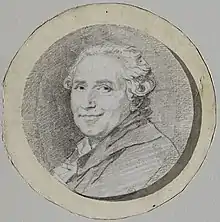 Self-Portrait, 1780s, black chalk with gray wash | |
| Born | 5 April 1732 Grasse, France |
| Died | 22 August 1806 (aged 74) Paris, France |
| Education | French Academy in Rome |
| Known for | Painting, drawing, etching |
| Notable work | The Swing, A Young Girl Reading, The Bolt |
| Movement | Rococo |
| Spouse | |
| Children | 2, including Alexandre-Évariste Fragonard |
| Awards | Prix de Rome |
Biography
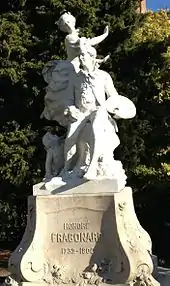
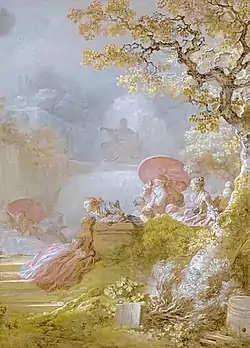
Jean-Honoré Fragonard was born at Grasse, Alpes-Maritimes, the son of François Fragonard, a glover, and Françoise Petit.[3] Fragonard was articled to a Paris notary when his father's circumstances became strained through unsuccessful speculations, but showed such talent and inclination for art that he was taken at the age of eighteen to François Boucher. Boucher recognized the youth's rare gifts but, disinclined to waste his time with one so inexperienced, sent him to Chardin's atelier. Fragonard studied for six months under the great luminist, then returned more fully equipped to Boucher, whose style he soon acquired so completely that the master entrusted him with the execution of replicas of his paintings.
Though not yet a student of the Academy, Fragonard gained the Prix de Rome in 1752 with a painting of Jeroboam Sacrificing to Idols, but before proceeding to Rome he continued to study for three years under Charles-André van Loo. In the year preceding his departure he painted the Christ washing the Feet of the Apostles now at Grasse Cathedral. On 17 September 1756, he took up his abode at the French Academy in Rome, then presided over by Charles-Joseph Natoire.
While at Rome, Fragonard contracted a friendship with a fellow painter, Hubert Robert. In 1760, they toured Italy together, executing numerous sketches of local scenery. It was in these romantic gardens, with their fountains, grottos, temples and terraces, that Fragonard conceived the dreams which he was subsequently to render in his art. He also learned to admire the masters of the Dutch and Flemish schools (Rubens, Hals, Rembrandt, Ruisdael), imitating their loose and vigorous brushstrokes. Added to this influence was the deep impression made upon his mind by the florid sumptuousness of Giovanni Battista Tiepolo, whose works he had an opportunity to study in Venice before he returned to Paris in 1761.
In 1765 his Coresus et Callirhoe secured his admission to the Academy. It was made the subject of a pompous (though not wholly serious) eulogy by Denis Diderot, and was bought by the king, who had it reproduced at the Gobelins factory. Hitherto Fragonard had hesitated between religious, classic and other subjects; but now the demand of the wealthy art patrons of Louis XV's pleasure-loving and licentious court turned him definitely towards those scenes of love and voluptuousness with which his name will ever be associated, and which are only made acceptable by the tender beauty of his color and the virtuosity of his facile brushwork; such works include the Blind Man's Bluff (Le collin maillard),[4] Serment d'amour (Love Vow), Le Verrou (The Bolt), La Culbute (The Tumble), La Chemise enlevée (The Raised Chemise), and L'escarpolette (The Swing, Wallace Collection), and his decorations for the apartments of Mme du Barry and the dancer Madeleine Guimard. The portrait of Diderot (1769) has recently had its attribution to Fragonard called into question.

A lukewarm response to these series of ambitious works induced Fragonard to abandon Rococo and to experiment with Neoclassicism. He married Marie-Anne Gérard, herself a painter of miniatures,[6] (1745–1823) on 17 June 1769 and had a daughter, Rosalie Fragonard (1769–1788), who became one of his favourite models. In October 1773, he again went to Italy with Pierre-Jacques Onézyme Bergeret de Grancourt and his son, Pierre-Jacques Bergeret de Grancourt. In September 1774, he returned through Vienna, Prague, Dresden, Frankfurt and Strasbourg.
Back in Paris Marguerite Gérard, his wife's 14-year-old sister, became his student and assistant in 1778. In 1780, he had a son, Alexandre-Évariste Fragonard (1780–1850), who eventually became a talented painter and sculptor. The French Revolution deprived Fragonard of his private patrons: they were either guillotined or exiled. The neglected painter deemed it prudent to leave Paris in 1790 and found shelter in the house of his cousin Alexandre Maubert at Grasse, which he decorated with the series of decorative panels known as the Les progrès de l'amour dans le cœur d'une jeune fille,[7] originally painted for Château du Barry.[8]
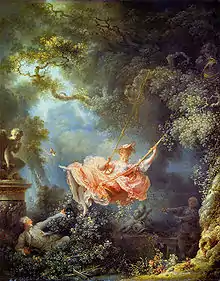
Fragonard returned to Paris early in the nineteenth century, where he died in 1806, almost completely forgotten.
Reputation
For half a century or more Fragonard was so completely ignored that Wilhelm Lübke's 1873 art history volume omits mention of his name.[9] Later re-evaluations have re-identified his position among the all-time masters of French painting. The influence of his handling of local colour and expressive, confident brushstroke on the Impressionists (particularly his grand niece, Berthe Morisot, and Renoir) is undoubtable. Fragonard's paintings, alongside those of François Boucher, seem to sum up an era.[10]
One of Fragonard's most renowned paintings is The Swing, also known as The Happy Accidents of the Swing (its original title), an oil painting in the Wallace Collection in London. It is considered to be one of the masterpieces of the rococo era, and is Fragonard's best known work.[11] The painting portrays a young gentleman concealed in the bushes, observing a lady on swing being pushed by her spouse, who is standing in the background, hidden in the shadows, as he is unaware of the affair. As the lady swings forward, the young man gets a glimpse under her dress. According to Charles Collé's memoirs[12] a young nobleman[13] had requested this portrait of his mistress seated on a swing. He asked first Gabriel François Doyen to make this painting of him and his mistress. Not comfortable with this frivolous work, Doyen refused and passed on the commission to Fragonard.[12]
Works
- Jean-Honoré Fragonard
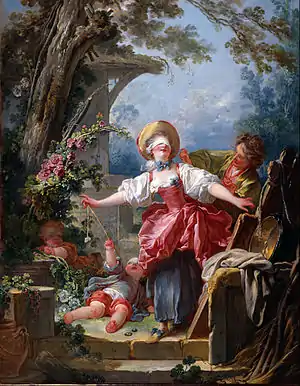
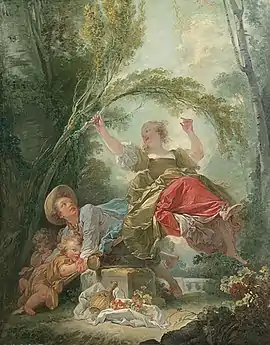 The See-Saw, 1750–1752, Thyssen-Bornemisza Museum, Madrid
The See-Saw, 1750–1752, Thyssen-Bornemisza Museum, Madrid The Birth of Venus, 1753–1755, Musée Grobet-Labadié, Marseille
The Birth of Venus, 1753–1755, Musée Grobet-Labadié, Marseille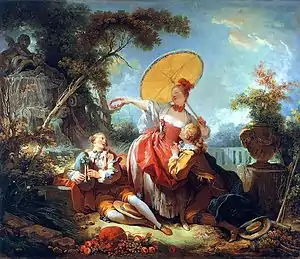 The Musical Contest, 1754–55, Wallace Collection, London
The Musical Contest, 1754–55, Wallace Collection, London Coresus Sacrificing himself to Save Callirhoe, 1765, Louvre, Paris
Coresus Sacrificing himself to Save Callirhoe, 1765, Louvre, Paris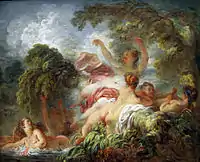 The Bathers, c. 1765, Louvre, Paris
The Bathers, c. 1765, Louvre, Paris Aurora Triumphing over Night, c. 1755-56, Museum of Fine Arts, Boston[14]
Aurora Triumphing over Night, c. 1755-56, Museum of Fine Arts, Boston[14] Inspiration, 1769, Louvre, Paris
Inspiration, 1769, Louvre, Paris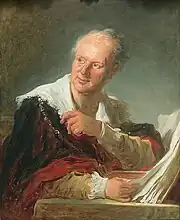 Portrait of a Man, the so-called Denis Diderot, 1769, Louvre, Paris
Portrait of a Man, the so-called Denis Diderot, 1769, Louvre, Paris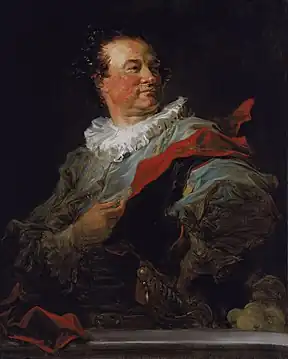 Portrait of François-Henri d'Harcourt, c. 1769, Accademia Carrara di Belle Arti di Bergamo, Bergamo
Portrait of François-Henri d'Harcourt, c. 1769, Accademia Carrara di Belle Arti di Bergamo, Bergamo The Love Letter, 1770, Metropolitan Museum of Art, New York
The Love Letter, 1770, Metropolitan Museum of Art, New York The Secret Meeting, 1771, (former collection of Madame Du Barry), Frick Collection, New York
The Secret Meeting, 1771, (former collection of Madame Du Barry), Frick Collection, New York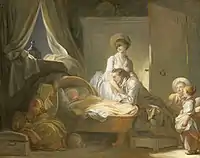 The Visit to the Nursery, c. 1775, National Gallery of Art, Washington, D.C.
The Visit to the Nursery, c. 1775, National Gallery of Art, Washington, D.C. A Young Girl Reading, c. 1776, National Gallery of Art, Washington, D.C.
A Young Girl Reading, c. 1776, National Gallery of Art, Washington, D.C.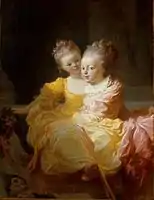 Sisters, after 1778, Metropolitan Museum of Art. New York
Sisters, after 1778, Metropolitan Museum of Art. New York The Stolen Kiss, late 1780s, Hermitage Museum, Saint Petersburg
The Stolen Kiss, late 1780s, Hermitage Museum, Saint Petersburg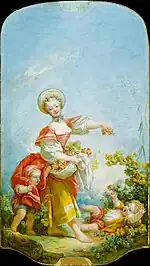 The Grape Gatherer, 1754–1755, Detroit Institute of Art, Detroit, Michigan
The Grape Gatherer, 1754–1755, Detroit Institute of Art, Detroit, Michigan Callirhoe's Sacrifice. Real Academia de Bellas Artes de San Fernando, Madrid. (ricordo from the large Coresus and Callirhoë)[15]
Callirhoe's Sacrifice. Real Academia de Bellas Artes de San Fernando, Madrid. (ricordo from the large Coresus and Callirhoë)[15]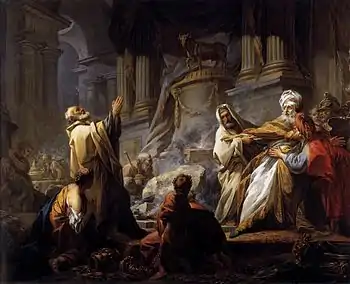 Jeroboam Offering Sacrifice for the Idol, 1752, Beaux-Arts de Paris, Paris.
Jeroboam Offering Sacrifice for the Idol, 1752, Beaux-Arts de Paris, Paris._-_Nationalmuseum_-_22465.tif.jpg.webp) The Beautiful Servant, Nationalmuseum, Stockholm
The Beautiful Servant, Nationalmuseum, Stockholm
Recent exhibitions
- Consuming Passion : Fragonard's Allegories of Love Archived 3 March 2020 at the Wayback Machine – Sterling and Francine Clark Art Institute, Williamstown, MA, from 28 October 2007 to 21 January 2008.
- Fragonard – Jacquemart-André Museum, Paris, from 3 October 2007 to 13 January 2008.
- Fragonard. Origines et influences. De Rembrandt au XXIe siècle Archived 29 November 2009 at the Wayback Machine – Caixa Forum, Barcelona, from 10 November 2006 to 11 February 2007.
- Les Fragonard de Besançon, Musée des Beaux-Arts et d'archéologie de Besançon, from 8 December 2006 to 2 April 2007: Official website
- Jean-Honoré Fragonard, dessins du Louvre, Musée du Louvre, Paris, from 3 December 2003 to 8 March 2004.
- Fragonard amoureux, Musée du Luxembourg, Paris, from 16 September 2015 to 24 January 2016: Official website
- Fragonard’s Enterprise: The Artist and the Literature of Travel – Norton Simon Museum, Pasadena, from 17 September 2015 to 4 January 2016.
References and sources
References
- Rosenberg, Pierre (1 January 1988). Fragonard. Metropolitan Museum of Art. ISBN 9780870995163.
-
Edmond and Jules de Goncourt (1881–1882). "Fragonard". L'Art du XVIIIe siècle. Vol. III. G. Charpentier. p. 241. ISBN 978-2-35548-008-9. Archived from the original on 19 November 2008. Retrieved 1 June 2009.
Voici l'acte de naissance de Fragonard, dont M. Sénequier veut bien nous envoyer la copie prise par lui sur les registres conservés à la mairie de Grasse : Année mille sept cent trente-deux. Le sixième avril, a été baptisé Jean-Honoré Fragonard, né le jour précédent, fils du sieur François, marchand, et de demoiselle Françoise Petit, son épouse; le parrain : sieur Jean-Honoré Fragonard, son aïeul, et la marraine demoiselle Gabrielle Petit, sa tante, tous de cette paroisse. Signé qui a su : Fragonard, Fragonard, Martin, curé.
(birth/baptism certificate) - Houël de Chaulieu, Philippe (May 2006). "L'histoire en marche; Anniversaire: Jean-Honoré Fragonard". Intermédiaire des chercheurs et curieux. No. 644. pp. 571–574. ISSN 0994-4532. Retrieved 9 May 2009.
- Milam, Jennifer (1998). "Fragonard and the blindman's game: Interpreting representations of Blindman's Buff". Art History. 21 (1): 1–25. doi:10.1111/1467-8365.00090. ISSN 0141-6790.
- "Chaumiére Italienne". lib.ugent.be. Retrieved 5 October 2020.
- Ferrand, Franck (2008). "Monsieur Fragonard". France Today. Vol. 23, no. 2. pp. 30–31. ISSN 0895-3651.
- Also known as "Roman d'amour de la jeunesse".
- Donald Posner (August 1972). "The True Path of Fragonard's 'Progress of Love'" (PDF). Burlington Magazine. Archived from the original (PDF) on 10 January 2014. Retrieved 21 February 2013.
- "The Project Gutenberg eBook of Encyclopædia Britannica, Volume X Slice VII – Fox, George to France".
- "Fragonard, Jean-Honoré", WebMuseum, Paris. Retrieved 22 June 2014.
- Ingamells, John, The Wallace Collection, Catalogue of Pictures, Vol III, French before 1815, 165, Wallace Collection, 1989, ISBN 0-900785-35-7,
- Collé, Charles (1868). Journal et mémoires de Charles Collé sur les hommes de lettres, les ouvrages dramatiques et les événements les plus mémorables du règne de Louis XV (1748–1772). Vol. III. Paris: Firmin Didot Frères, Fils et Cie. pp. 165–166.
- Although his identity was not unveiled by Collé, it has been thought that it was Marie-François-David Bollioud de Saint-Julien, baron of Argental (1713–1788), best known as Baron de Saint-Julien, the then Receiver General of the French Clergy. However there is little evidence for this, according to Ingamells, 163–164.
- Aurora Triumphing over Night
- Fernando, Real Academia de BBAA de San. "Fragonard, Jean Honoré - El sacrificio de Caliroe". Academia Colecciones (in Spanish). Retrieved 17 March 2021.
Sources
Books
- This article incorporates text from a publication now in the public domain: Chisholm, Hugh, ed. (1911). "Fragonard, Jean-Honoré". Encyclopædia Britannica. Vol. 10 (11th ed.). Cambridge University Press. pp. 772–773.
- Edmond and Jules de Goncourt (1881–1882). "Fragonard". L'Art du XVIIIe siècle. Vol. III. G. Charpentier. p. 241. ISBN 978-2-35548-008-9. Archived from the original on 19 November 2008. Retrieved 10 May 2009.
- Eva-Gesine Baur (2007). Rococo. Taschen. ISBN 978-3-8228-5306-1.
- Jean Montague Massengale (1993). Jean-Honore Fragonard. Harry N. Abrams, Inc. ISBN 0-8109-3313-6.
Articles and webpages
- Lajer-Burcharth, Ewa (2003). "Fragonard in Detail". Differences: A Journal of Feminist Cultural Studies. 14 (3): 34–56. doi:10.1215/10407391-14-3-34. ISSN 1040-7391. S2CID 144003749.
- Simon, Jonathan (2002). "The Theater of Anatomy: The Anatomical Preparations of Honore Fragonard". Eighteenth-Century Studies. 36 (1): 63–79. doi:10.1353/ecs.2002.0066. ISSN 0013-2586. S2CID 162293464.
- Sheriff, Mary D. (1987). "Invention, Resemblance, and Fragonard's Portraits de Fantaisie". Art Bulletin. 69 (1): 77–87. doi:10.1080/00043079.1987.10788403. ISSN 0004-3079.
- Ferrand, Franck (2008). "Monsieur Fragonard". France Today. Vol. 23, no. 2. pp. 30–31. ISSN 0895-3651.
- McEwen, J. (1988). "Fragonard: Rococo or romantic?". Art in America. Vol. 76, no. 2. p. 84. ISSN 0004-3214.
- Milam, Jennifer (1998). "Fragonard and the blindman's game: Interpreting representations of Blindman's Buff". Art History. 21 (1): 1–25. doi:10.1111/1467-8365.00090. ISSN 0141-6790.
- Milam, Jennifer (2000). "Playful Constructions and Fragonard's Swinging Scenes". Eighteenth-Century Studies. 33 (4): 543–559. doi:10.1353/ecs.2000.0042. ISSN 0013-2586. S2CID 162283094.
Further reading
- Dore Ashton (1988). Fragonard in the Universe of Painting. Smithsonian Institution Press. ISBN 0-87474-208-0.
- Mary Sheriff (1990). Fragonard: Art and Eroticism. The University of Chicago Press. ISBN 0-226-75273-9.
- Jean-Pierre Cuzin (1988). Jean-Honore Fragonard: Life and Work. Complete Catalogue of the Oil Paintings. Harry N. Abrams, Inc. ISBN 0-8109-0949-9.
- David Wakefield (1976). Fragonard. London: Oresko Books. ISBN 0-905368-01-0.
- Georges Wildenstein (1960). The Paintings of Fragonard. Phaidon.
- Martha Richler (1997). "18th century". National Gallery of Art Washington A World of Art. Scala Publishers Ltd. ISBN 1-85759-187-9.
- Percival, Melissa (2017) [2012]. Fragonard and the Fantasy Figure: Painting the Imagination. London, New York: Routledge. ISBN 978-1-4094-0137-7 – via Google Books.
- Milton W. Brown, George R. Collins, Beatrice Farwell, Jane G. Mahler and Margaretta Salinger, "Jean-Honoré Fragonard" in Encyclopedia of Painting: Painters and Paintings of the World from Prehistoric Times to the Present Day, Myers S. Bernard (ed), Crown, 1955. pp182–83.
External links
| External video | |
|---|---|
![]() Media related to Jean-Honoré Fragonard at Wikimedia Commons
Media related to Jean-Honoré Fragonard at Wikimedia Commons